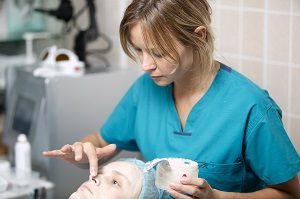As we age, it becomes increasingly important to take care of our skin and be mindful of any changes that occur.
Whereas in our twenties our skin forgave any abuse we threw its way, in our forties, we start to see the effects of those abuses from harmless age spots to increased risk of developing melanoma.
However, some conditions can look much scarier than they actually are.
One such condition is stucco keratosis.
Below is everything you need to know about this condition such as what it is, causes and treatment, action steps, and current scientific research about the condition.
What Is Stucco Keratosis?
According to Dr. Katherine H. Fiala in Medscape, stucco keratosis is a condition that affects the epidermis (top layer) of the skin in the lower extremities (most commonly the feet and ankles).(1)
It is characterized by a series of benign tumors (lesions) that are typically white in color and are described as looking like church spires. Since these lesions only occur in the top layer of the skin, these tumors look as if they are “stuck on,” from which the name “stucco” is derived.
A patient with this condition can have anywhere from seven to more than one hundred lesions which are frequently interspersed with viral warts.
These lesions also cause a characteristic thickening of the skin. Stucco keratosis is most common in adults over the age of 45 and occurs in men four times more than it occurs in women.(1)
In fact, this condition reportedly affects roughly 10% of seniors in the U.S with research indicating that it is equally prevalent among all races and ethnic groups.(1)
Although stucco keratosis is a benign condition, the occurrence of multiple oddly-shaped tumors means that this condition is easily mistaken for melanoma. Fortunately, melanoma has a number of hallmark signs, which means that a quick visit to the dermatologist can easily rule it out and give the patient peace of mind.
Causes
 According to Dr. Cleaver of Cleaver Dermatology, researchers have been unable to pinpoint an exact cause of stucco keratosis at this time, though recent findings have opened up promising avenues of research.(2)
According to Dr. Cleaver of Cleaver Dermatology, researchers have been unable to pinpoint an exact cause of stucco keratosis at this time, though recent findings have opened up promising avenues of research.(2)
Some studies have found certain strains of the human papillomavirus (HPV) in about 20% of warts associated with the condition, though researchers haven’t been able to pinpoint if the presence of the virus is a causal factor or coincidental.(2)
Another proposed possible cause is sun damage.
Many patients with this health issue also show signs of sun damage in the skin, though more research needs to be done to see if the sun damage is directly related to the condition or if it is merely due to advanced age (middle aged and older individuals—the population most affected by stucco keratosis—are more likely to show signs of sun damage than younger adults).
One factor that could potentially debunk this theory is that stucco keratosis only affects the lower extremities, not the face (which typically receives the most sun exposure).
So far, according to Christian Hafner in the Journal of Family Practice, the theory with the strongest amount of support is that stucco keratosis is a variation of hyperkeratotic seborrheic keratosis, another condition that causes benign tumors in the epidermis layer of the skin.(3)
This theory is supported by the fact that the two conditions share a genetic mutation called PIK3CA. Further research needs to be done to determine if this connection is statistically relevant.
Treatment
 Since the tumors caused by stucco keratosis are completely benign with no potential for turning malignant and invading other parts of the body, patients with this condition are not required to pursue treatment if the condition doesn’t bother them.
Since the tumors caused by stucco keratosis are completely benign with no potential for turning malignant and invading other parts of the body, patients with this condition are not required to pursue treatment if the condition doesn’t bother them.
Those who do decide to seek treatment typically do so for aesthetic reasons rather than health reasons. Still, for those are experiencing psychological effects as a result of the condition, receiving treatment can have a dramatic effect on self-esteem.
According to Cleaver Dermatology, for those who decide to remove the lesions, patients can choose from a variety of treatment options, though not all of them work for every patient.(2)
Many are the same that dermatologists use to remove warts, such as cryotherapy (freezing the lesions off) or scraping the lesions off. Patients can also opt to have the lesions surgically removed.
A more experimental treatment is electro-desiccation, where the dermatologist applies a needle-shaped electrode to the affected area and runs an electric current to try the lesions out.
Other treatment options include medical creams. Imiquimod, for example, is a topical cream commonly used to treat warts. Due to the presence of the HPV virus in many of the warts associated with stucco keratosis, Imiquimod cream has worked for a small number of patients.
Another topical treatment is Etretinate, a cream used to treat psoriasis. Once again, this treatment option has only proven successful in a minority of patients.
What to Do?
 If you are starting to notice lesions on your skin, the first thing you should do is learn how to spot the warning signs of melanoma.
If you are starting to notice lesions on your skin, the first thing you should do is learn how to spot the warning signs of melanoma.
According to the Skin Cancer Foundation, melanoma is ranked as the most deadly type of skin cancer.(4)
These malignant tumors can start as moles and spread throughout the body, killing about 10,130 Americans a year.
While typically melanoma tumors are dark in color, occasionally they can present as lighter colors such as white, pink, blue or skin-colored. As such, it is important to learn how to differentiate malignant melanoma tumors from benign stucco keratosis tumors.
A quick and simple way to analyze unusual changes in your skin is to use the ABCDEs of melanoma.
These include:(5)
Asymmetry: Benign tumors are symmetrical in shape, while melanoma is asymmetrical. This means that in a benign tumor, if you were to draw a line down the middle, both sides would be equal, like a mirror image. If the two sides are unequal, you should get checked for melanoma.
Border: You should also take a look at the outside borders. In benign tumors or moles, the outer edges are smooth and even. In melanoma, the edges are uneven and possibly jagged.
Color: While benign moles and tumors have a single, uniform color, melanoma is characterized by a variety of colors in a single tumor.
Diameter: Benign tumors are also much smaller than melanoma tumors. A benign tumor is typically smaller than the diameter of a pencil eraser (about ¼ inch or 6 millimeters), melanoma tumors can grow much larger unless you manage to catch it in the early stages.
Evolving: Benign tumors and moles tend to stay the same over time, while malignant tumors can grow in size and change color, shape, texture, etc.
To summarize, a benign tumor or lesion such as those caused by this condition is one that is stable, uniform, and unchanging over time. Anything else can be a warning sign for melanoma.
When Should You See a Doctor
 You should always see a doctor if you notice any unusual changes in your skin.
You should always see a doctor if you notice any unusual changes in your skin.
Even if the ABCDE test rules the tumor out as being symptomatic of possible melanoma, a check-up with your doctor can give you peace of mind and help you get to the bottom of what the condition actually is.
An official diagnosis can give you a clearer sense of direction on the next steps you should take.
Since a more malignant condition can be easily camouflaged by the lesions caused by stucco keratosis, a dermatologist can also teach you how to monitor your condition and which warning signs to look out for.
Furthermore, since existing treatment options for getting rid of the lesions require either medical procedures or a prescription cream, seeing a doctor can help you decide on a course of action that is right for you.
Scientific Studies
Since—according to Medscape—the condition wasn’t first discovered until 1965 by Kocsard and Ofner and later confirmed in 1972 by Willoughby and Soter, progress within the scientific community has been slow.(1)
Christian Hafner’s article in the Journal of Family Practice chronicled some of the most recent breakthroughs:(2)
- 2000: Researchers Stockfleth, Rowert, Arndt, Christophers, and Meyer discovered the presence of the HPV virus in some cases of stucco keratosis.
- 2010: Hafner, Landthaler, Mentzel, and Vogt discovered the presence of the PIK3CA mutation. A similar study found the same mutation in seborrheic keratosis.
As you can see, current research is dedicated to finding the cause of the condition in order to find more effective treatments.
In short, stucco keratosis is a fairly common skin condition among adults over 45.
Although it is associated with numerous small tumors, the condition is actually benign.
While the cause is still unknown, multiple treatment options are available to you and scientific research is dedicated to finding the cause.
If you suspect that you may have stucco keratosis, some action steps that you should take include:
» Learn the ABCDEs of melanoma to rule out malignant tumors
» See a doctor to officially rule out cancer and get an official diagnosis
» Decide if you want to pursue treatment and discuss treatment options with your dermatologist
References
(1)http://emedicine.medscape.com/article/1059798-overview#a4
(2)http://www.cleaverderm.com/stucco-keratosis.html
(3)http://www.mdedge.com/jfponline/dsm/565/dermatology/stucco-keratosis-keratosis-alba#cont3
(4)http://www.skincancer.org/skin-cancer-information/melanoma#panel1-5
(5)https://www.melanoma.org/understand-melanoma/diagnosing-melanoma/detection-screening/abcdes-melanoma
Leave Feedback: Was this article helpful?

